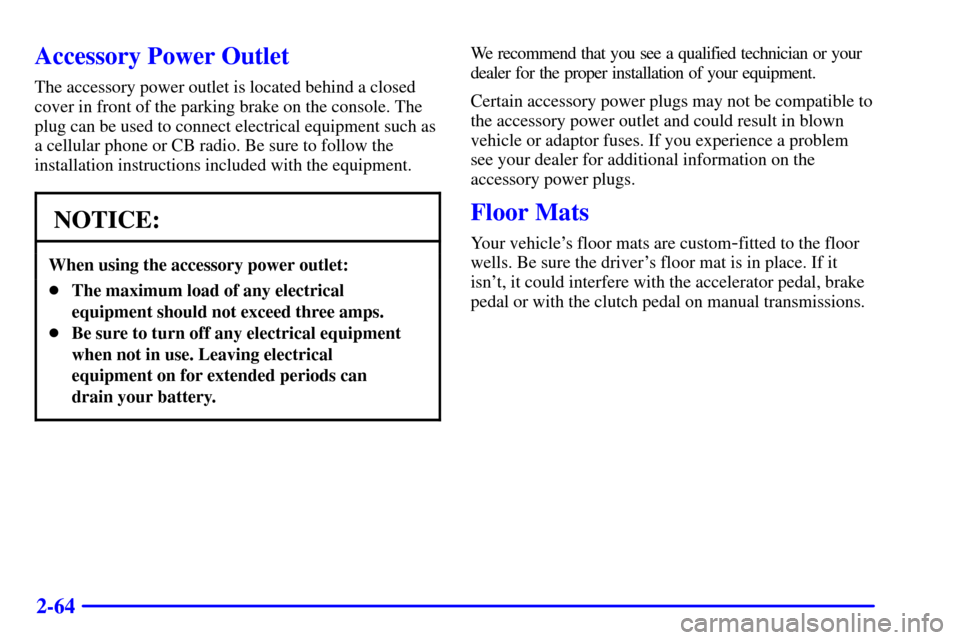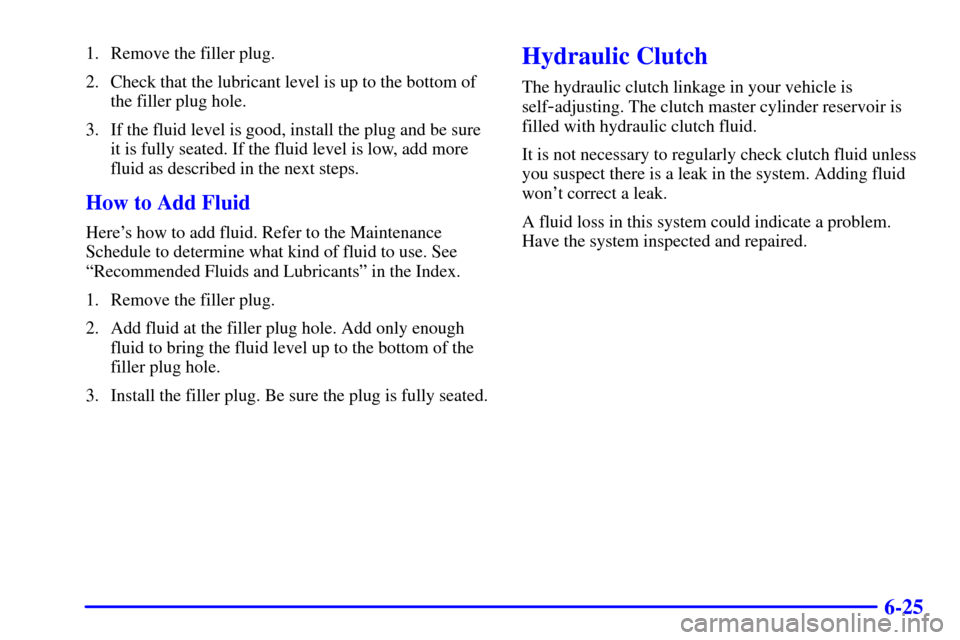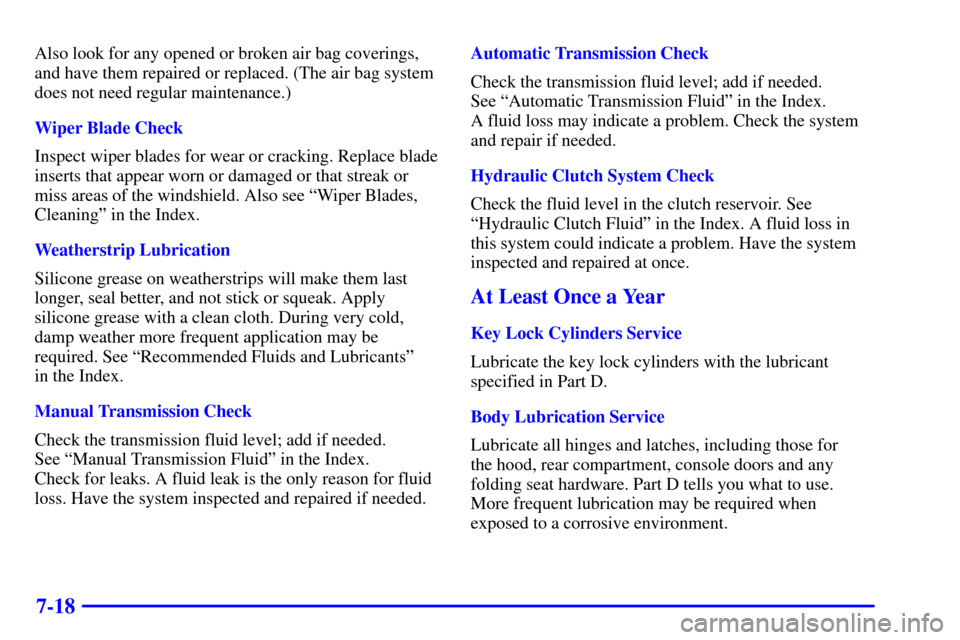Page 122 of 363

2-64
Accessory Power Outlet
The accessory power outlet is located behind a closed
cover in front of the parking brake on the console. The
plug can be used to connect electrical equipment such as
a cellular phone or CB radio. Be sure to follow the
installation instructions included with the equipment.
NOTICE:
When using the accessory power outlet:
�The maximum load of any electrical
equipment should not exceed three amps.
�Be sure to turn off any electrical equipment
when not in use. Leaving electrical
equipment on for extended periods can
drain your battery.
We recommend that you see a qualified technician or your
dealer for the proper installation of your equipment.
Certain accessory power plugs may not be compatible to
the accessory power outlet and could result in blown
vehicle or adaptor fuses. If you experience a problem
see your dealer for additional information on the
accessory power plugs.
Floor Mats
Your vehicle's floor mats are custom-fitted to the floor
wells. Be sure the driver's floor mat is in place. If it
isn't, it could interfere with the accelerator pedal, brake
pedal or with the clutch pedal on manual transmissions.
Page 255 of 363

6-
6-1
Section 6 Service and Appearance Care
Here you will find information about the care of your vehicle. This section begins with service and fuel information,
and then it shows how to check important fluid and lubricant levels. There is also technical information about your
vehicle, and a part devoted to its appearance care.
6
-2 Service
6
-3 Fuel
6
-5 Fuels in Foreign Countries
6
-6 Filling Your Tank
6
-8 Filling a Portable Fuel Container
6
-8 Checking Things Under the Hood
6
-10 Engine Compartment Overview
6
-12 Engine Oil
6
-18 Engine Air Cleaner/Filter
6
-20 Automatic Transmission Fluid
6
-24 Manual Transmission Fluid
6
-25 Hydraulic Clutch
6
-26 Rear Axle
6
-27 Engine Coolant
6
-30 Power Steering Fluid
6
-32 Windshield Washer Fluid
6
-33 Brakes
6
-37 Battery
6
-37 Bulb Replacement6
-43 Tires
6
-52 Appearance Care
6
-52 Cleaning the Inside of Your Vehicle
6
-54 Care of Safety Belts
6
-55 Cleaning Glass Surfaces
6
-56 Cleaning a Removeable Roof Panel
6
-56 Cleaning the Outside of Your Vehicle
6
-57 Cleaning Your Convertible Top
6
-58 Cleaning Aluminum or Chrome-Plated
Wheels (If Equipped)
6
-59 Underbody Maintenance
6
-60 GM Vehicle Care/Appearance Materials
6
-61 Vehicle Identification Number (VIN)
6
-61 Service Parts Identification Label
6
-62 Electrical System
6
-68 Replacement Bulbs
6
-69 Capacities and Specifications
6
-70 Normal Maintenance Replacement Parts
Page 264 of 363
6-10 Engine Compartment Overview
When you open the hood of the 3800 V6 engine, you'll see:
A. Engine Coolant Reservoir
B. Battery
C. Radiator Pressure Cap
D. Engine Oil Fill Cap
E. Automatic Transmission Fluid
Dipstick (If Equipped)F. Windshield Washer
Fluid Reservoir
G. Engine Cooling Fans
H. Engine Air Cleaner/Filter
I. Power Steering Fluid ReservoirJ. Engine Oil Dipstick
K. Brake Fluid Reservoir
L. Clutch Fluid Reservoir
(If Equipped)
Page 265 of 363
6-11
When you open the hood of the 5.7L V8 engine, you'll see:
A. Engine Coolant Reservoir
B. Battery
C. Radiator Pressure Cap
D. Engine Oil Dipstick
E. Engine Oil Fill CapF. Windshield Washer
Fluid Reservoir
G. Engine Cooling Fans
H. Automatic Transmission Fluid
Dipstick (If Equipped)I. Engine Air Cleaner/Filter
J. Power Steering Fluid Reservoir
K. Brake Fluid Reservoir
L. Clutch Fluid Reservoir
(If Equipped)
Before closing the hood, be sure all the filler caps are on.
Then pull the hood down and close it firmly.
Page 279 of 363

6-25
1. Remove the filler plug.
2. Check that the lubricant level is up to the bottom of
the filler plug hole.
3. If the fluid level is good, install the plug and be sure
it is fully seated. If the fluid level is low, add more
fluid as described in the next steps.
How to Add Fluid
Here's how to add fluid. Refer to the Maintenance
Schedule to determine what kind of fluid to use. See
ªRecommended Fluids and Lubricantsº in the Index.
1. Remove the filler plug.
2. Add fluid at the filler plug hole. Add only enough
fluid to bring the fluid level up to the bottom of the
filler plug hole.
3. Install the filler plug. Be sure the plug is fully seated.
Hydraulic Clutch
The hydraulic clutch linkage in your vehicle is
self
-adjusting. The clutch master cylinder reservoir is
filled with hydraulic clutch fluid.
It is not necessary to regularly check clutch fluid unless
you suspect there is a leak in the system. Adding fluid
won't correct a leak.
A fluid loss in this system could indicate a problem.
Have the system inspected and repaired.
Page 280 of 363

6-26 When to Check and What to Use
See ªEngine Compartment Overviewº in the Index for
information on location.
Refer to the Maintenance Schedule to determine how
often you should check the fluid level in your clutch
master cylinder reservoir and for the proper fluid. See
ªOwner Checks and Servicesº and ªRecommended
Fluids and Lubricantsº in the Index.
How to Check and Add Fluid
The proper fluid should be added if the level is below
the plastic step on the reservoir. See the instructions on
the reservoir cap. See ªEngine Compartment Overviewº
in the Index for more information on location.
Rear Axle
When to Check and Change Lubricant
Refer to the Maintenance Schedule to determine how
often to check the lubricant and when to change it.
See ªScheduled Maintenance Servicesº in the Index.
How to Check Lubricant
If the level is below the bottom of the filler plug hole,
you'll need to add some lubricant. Add enough lubricant
to raise the level to the bottom of the filler plug hole.
What to Use
Standard Differential
Use SAE 75W
-90 Synthetic Gear Lubricant
(GM Part No. 12378261) or equivalent meeting
GM Specification 9986115.
Page 321 of 363
6-67
Fuse and Relay Center 2
Fuse Usage
INJ
-2 Fuel Injectors (Not Used for V6)
(LH Injectors for V8 and
Ignition Module)
INJ
-1 Fuel Injectors (All for V6)
(RH Injectors for V8 and
Ignition Module)
ENG SEN Mass Air Flow, Heated Oxygen
Sensor, Skip Shift Solenoid
(V8 Only), Reverse Lockout
Solenoid, Brake SwitchFuse Usage
STRTR Powertrain Control Module
(PCM) and Clutch Pedal Switch
ABS IGN Anti
-Lock Brake System Module
PCM IGN Powertrain Control
Module (PCM)
ETC Electronic Throttle
Control (V6 Only)
ENG CTRL Ignition Module (V6 Only),
Automatic Transmission and
Charcoal Canister Purge Solenoid
A/C CRUISE Air Conditioning Compressor
Relay, Cruise Control Switches
and Module
ENG CTRL Engine Controls, Fuel Pump,
Powertrain Control Module
(PCM), A.I.R. and Cooling Fans
I/P
-1 HVAC Blower Control and Relay
IGN Ignition Switch, Relay and Starter
Enable Relay
I/P
-2 Instrument Panel Fuse Center
Page 342 of 363

7-18
Also look for any opened or broken air bag coverings,
and have them repaired or replaced. (The air bag system
does not need regular maintenance.)
Wiper Blade Check
Inspect wiper blades for wear or cracking. Replace blade
inserts that appear worn or damaged or that streak or
miss areas of the windshield. Also see ªWiper Blades,
Cleaningº in the Index.
Weatherstrip Lubrication
Silicone grease on weatherstrips will make them last
longer, seal better, and not stick or squeak. Apply
silicone grease with a clean cloth. During very cold,
damp weather more frequent application may be
required. See ªRecommended Fluids and Lubricantsº
in the Index.
Manual Transmission Check
Check the transmission fluid level; add if needed.
See ªManual Transmission Fluidº in the Index.
Check for leaks. A fluid leak is the only reason for fluid
loss. Have the system inspected and repaired if needed.Automatic Transmission Check
Check the transmission fluid level; add if needed.
See ªAutomatic Transmission Fluidº in the Index.
A fluid loss may indicate a problem. Check the system
and repair if needed.
Hydraulic Clutch System Check
Check the fluid level in the clutch reservoir. See
ªHydraulic Clutch Fluidº in the Index. A fluid loss in
this system could indicate a problem. Have the system
inspected and repaired at once.
At Least Once a Year
Key Lock Cylinders Service
Lubricate the key lock cylinders with the lubricant
specified in Part D.
Body Lubrication Service
Lubricate all hinges and latches, including those for
the hood, rear compartment, console doors and any
folding seat hardware. Part D tells you what to use.
More frequent lubrication may be required when
exposed to a corrosive environment.